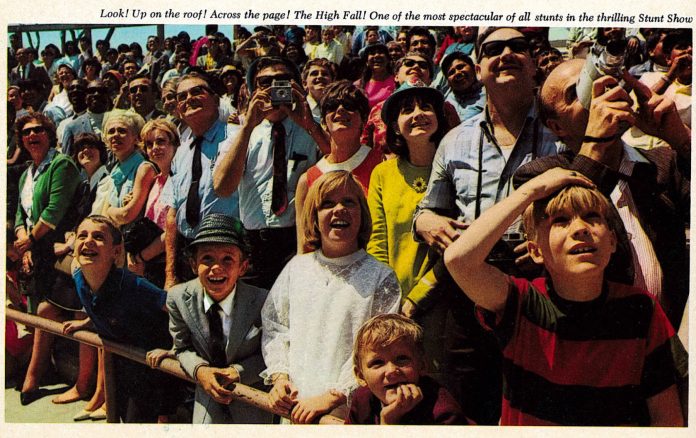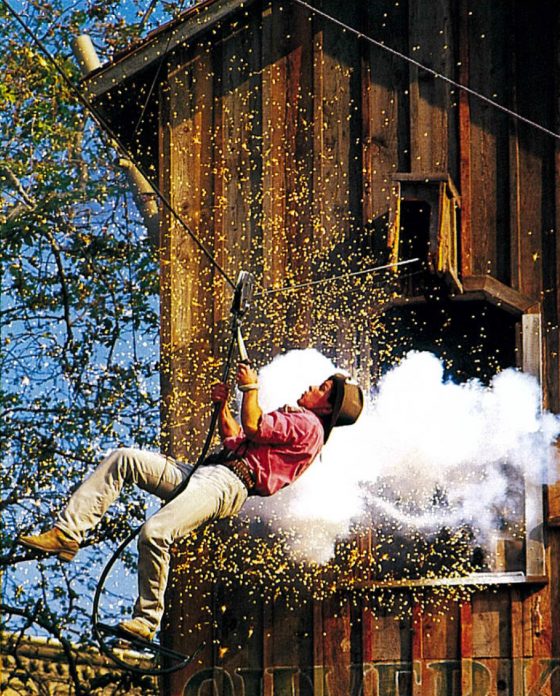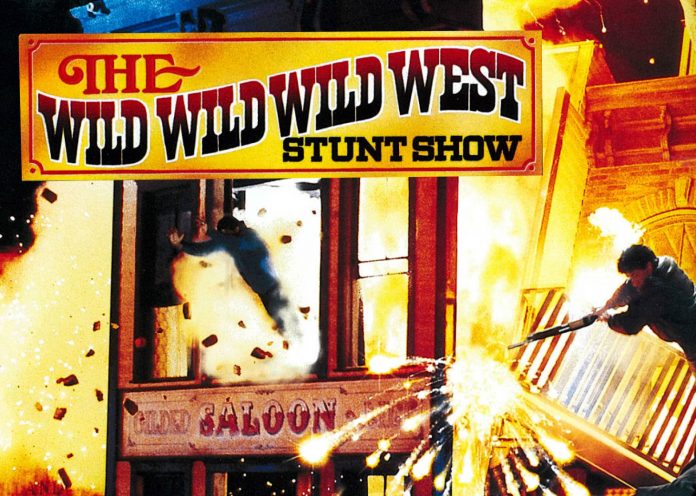As a child of the 80s, one of my favorite things about going to Universal Studios Hollywood was the abundance of stunt shows in the park. Every visit allowed me to watch in awe; The Adventures of Conan, Miami Vice Action Spectacular, and (my favorite) The Western Stunt Show/Wild Wild Wild West Stunt Show. While Universal didn’t invent the concept of a stunt show, they certainly perfected it. Universal Studios Hollywood and Universal Orlando became the showcase of stunt shows, from the basic movie-punch and highfall to the Bourne Stuntacular, they’ve set the standard of entertainment. To fully appreciate where we are now, we’re going to take a look back at the history of the western stunt show at Universal Studios Hollywood.
An interesting thing to note is when one thinks of historical events that have happened on the Universal property, most people would never know that something even bigger took place 68 years prior to the opening of the Universal film studio. In 1847 Mexico and the USA signed the Treaty of Cahuenga which ended the fighting of the Mexican-American war. So, when you’re on the Studio Tour and going through Fast and Furious Supercharged, just remember this is where the treaty was signed to end a war.
The entertainment industry has been built by individuals whose minds overflow with creativity and the willingness to take chances and go where no person has gone before. Carl Laemmle was willing to push the envelope and take those chances. On March 15, 1915, Carl Laemmle opened Universal Pictures out West, where he purchased 230 acres of land for $165,000. Universal City was now the Mecca of the entertainment industry. The studio opened with two soundstages, a chicken ranch, mills, and 15,000 guests waiting to enter the studio. Visitors came from all around the country to see what Laemmle was up to.

Everyone who has taken the Studio Tour over the years heard the story of Carl Laemmle inviting guests to come to visit the studio for 25 cents and watch silent movies filmed on the studio, and the admission price included lunch. However, in 1929, talkies came to Hollywood, which sadly meant guests were no longer allowed on set.
While Carl was influential in bringing new experiences to the studio, it wouldn’t be until 1963 when Lew Wasserman CEO of MCA Inc, the last of the Hollywood movie moguls – Jules Stein Chairman of MCA Inc, had Vice President of MCA Inc. Al Dorskind develop a new version of the Studio Tour. The early tests of the tour consisted of Grey Line buses traversing through the studio property which by that time had increased to 36 soundstages. When the decision was made for Universal to have its own tram, Harper Goff of Disney fame designed what would become known as the Glamour Tram.
The tour was a hit from the beginning. In 1965, Universal began its first park expansion with the new $5,000,000 Visitor’s Entertainment Center. Over the first 4 years, the Universal Studios Tour welcomed in excess of 3,000,000 guests. Incorporated within the new Visitor’s Entertainment Center were four offerings; a make-up demonstration, Ma and Pa Kettle’s Farm, an animal show under the direction of famed animal trainer Ray Berwick, and a western stunt show.
The Western Stunt Show had three locations during its run; The first was Stage 70 which is currently the location of the Special Effects Show (also known as Castle Theatre), then the show was held temporarily at the Universal Amphitheatre back when it was an outdoor venue, and its final location was where Universal Plaza currently sits.
The first incarnation of the stunt show was much more of a demonstration than a show with a storyline. It was designed to demonstrate how to throw punches, negotiate high falls, and end with a gunfight. Some of the original stunt performers included Stephen Burnett, Hank Colea, Arnold Roberts, and Joe Pronto. (Oddly enough, Joe Pronto would perform the high falls even though he was afraid of heights). During this time, Universal had what was known as “Star of the Day”, an event where actors would interact with visitors a few moments before the show began. Stars included Mike Farrell (M*A*S*H), Bob Hastings, Ricardo Maltoban (Fantasy Island), and Bob Denver (Gilligan’s Island).
In 1968, an important shift took place at Universal when the stunt show performers were sent to Texas for a promotion. To fill in during their absence Lance Rimmer, a stuntman from 20th Century Fox was brought in part-time. Within a few days, Lance, without asking permission, decided to change the show, adding a storyline, a villain, and a comic. While the show was simple, it provided a fresh look with newly added bullwhips, more gunfights, and humor.
The show lasted several days before management found out and they were not happy with the changes. Lance was called into a meeting with John Lake (General Manager), the Entertainment Manager, and Jay Stein. Jay was known as someone who liked to yell and was quick to fire people, but he was also a smart business person.
In a conversation with Lance a few years back he recalled this meeting.
Jay shouted at Lance: “You changed my show!”
The Entertainment Manager then chimed in with “You’re trying to turn it into a comedy, and I don’t like a funny stunt show”.
Lance came back at the three of them with “It doesn’t matter what you like, it matters what the audience likes.”
Lance was very careful to explain to management that this was a stunt show with comedy and not a comedy stunt show. After cooler heads prevailed, Jay agreed to a four-week test, two weeks of old shows, and two weeks of Lance’s show. Jay loved his surveys and would have an independent company survey audiences. If Lance’s version received higher ratings, he would keep his job and the new show would stay. If not, the old show comes back and Lance was out.
After four weeks, the surveys came back in favor of Lance’s version. Management did make a couple of tweaks, with one being to add the quicksand pit. Lance in turn brought in some of the most sought-after stunt performers in Hollywood – Steve Gillam, Tom Morga, and would later add Carl Ciarfalio and John Casino.
Horror fans might recognize the name Tom Morga for his portrayal of Jason Vorhees in Friday the 13th: The New Beginning, Leatherface in Texas Chainsaw Massacre 2, and Michael Myers in Halloween 4: The Return of Michael Myers (however, he ended up being replaced midway through production). Tom wouldn’t be the only western stunt performer at Universal to portray a horror icon though, as Derek Mears, who played Claude in the Wild Wild Wild West version, would portray Jason Vorhees in the 2009 reboot of Friday the 13th.
The show has had its dramatic and scary incidents over the years. Lance and Steve were in the midst of a gunfight during the show when the wadding from a blank bullet fired by Lance hit Steve in the eye, which permanently damaged it.
As the theme park became ever more popular with guests, Universal was looking at new ways to promote the park in North America. In 1978, Universal began a traveling roadshow that toured malls across the United States including a one-month stint in Canada.
The roadshow consisted of three acts:
-
- The Animal Show with Bryan Renfro included Fred the Cockatoo from the television show Baretta, who would answer a phone, then roll onto his back and drink from an airline liquor bottle. Benji the dog was also a popular hit.
-
- A Make-Up demonstration where a guest from the audience would be made up as the Bride of Frankenstein.
-
- A 3-person western-themed stunt show which included a bullwhip, breakaway bottles, and a knife/gunfight.
The tour would go on for 3 years until they handed it off to an independent owner who continued the tour throughout the 1980s.
While the Lance Rimmer version of the stunt show remained popular, Universal felt the need to give the show a major facelift and in 1990 they debuted an all-new stunt called “The Riot Act”. While the name of the show sounds nothing like a western-themed stunt show it was in fact just that and the reviews from guests and the LA Times were painful. The premise of the show was a five-person troupe with characters named Brett Taylor and Felix Cassidy. Shortly after the show started with Brett and Felix, the villains, Ma Hopper, Cole, and the “little one” Claude appear to take over the show as they’ve booted out the rest of the stunt team. The show also featured a horse that Brett Taylor would ride onto the set.
Universal hired famed film director John Landis to direct an original commercial for the new show. However, the commercial was met with a bit of controversy. The LA Times wrote an article reviewing the new Riot Act show, with the headline stating, “’Riot Act’ Doesn’t Deliver One: Advertising: Universal Studios’ commercial for a stunt show is misleading. There are no police cars or riots, just the same old cowboys in a new show.”
The LA Times article details the commercial as such “Police cars racing through Los Angeles streets in response to a disturbance call. Subsequent scenes show burly men fighting Karate-style and breaking chairs over one another’s backs. At the end of the ad, five patrol cars pull up to the show’s stage, which is alight with fires and explosions. “The Riot Act” appears across the screen in scrawled, graffiti-like letters.”
Due to guest and media complaints, Universal ditched the Landis commercial and spliced together guest reaction shots with short clips of fighting as well as a guy being thrown through a window. In 1992, the LA Riots caused Universal to change the name from “The Riot Act” to “Wild Wild Wild West Stunt Show”.
Like the original stunt show, the revised version also had its near disaster. One of the stunts had the comic sit on a long beam while the villain lifted the beam and swung it over the audience having Felix soar above. Unfortunately, during one performance the beam broke and the comic came crashing down. Fortunately, the performer avoided injury and was unharmed. The stunt was then cut from the Hollywood version. However, there is a video of the accident on YouTube.
In 1999, Universal Studios Hollywood was struggling with attendance and budget cuts hit the park hard, even though only three years before Jurassic Park River Adventure had opened to record crowds. Universal closed Beetlejuice’s Rockin’ Graveyard Revue, the Doo Wop Singers were canned and the horse from the Wild Wild Wild West Show marked the first major cut to the stunt show.
Over the years the western stunt show proved to be so popular that Universal cloned the show for Universal Studios Florida and Universal Studios Japan. While the Japan version did share the same name, the show itself was quite different. The Florida version ran till 2003 and was replaced by Fear Factor Live. The Japan version had a shorter run from 2001-2006 and was replaced by an Oz-themed land and a shortened version of the Broadway hit Wicked.
However, fast forward to January 6, 2002, more budget cuts came to Universal when they closed the Wild Wild Wild West Stunt Show. However, that would not be the last time the show performed. During the 4th of July peak season of the same year, Universal was in a jam and decided to reopen the stunt show for two weeks with limited effects. This was the same year Universal rebranded the Animal Actors into Animal Planet Live!
The Hollywood version may have been the one that started it all, but it was sadly the first to close. The concept of the western stunt show still goes on strong in other parks across the country and stunt shows like WaterWorld and The Bourne Stuntacular have grown larger and more technical, but nothing will ever beat the simpler and less technical western stunt show that Universal perfected in the late ‘60s through the 1990s.



